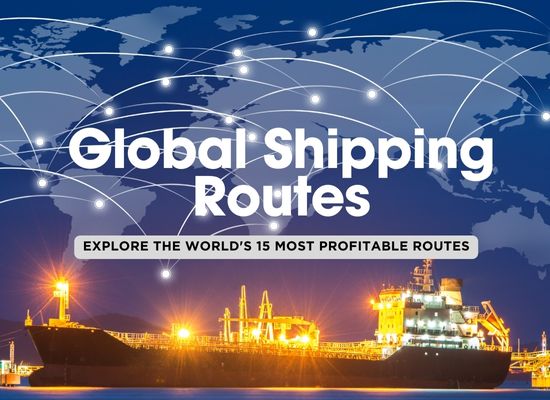Top 15 Most Profitable Shipping Routes and the Goods They Carry

The global shipping industry thrives on specific trade routes that are key to the movement of goods. These routes are not only the lifeblood of international commerce but also lucrative corridors for shipping companies. Below, we explore the top 15 in-depth, covering key factors that make them profitable, the types of goods they handle, and critical insights.

1. Asia-Europe Route: The Trade Superhighway 🚢
- Primary Ports: Shanghai (China), Singapore (Singapore), Rotterdam (Netherlands), Hamburg (Germany).
- Primary Goods: Electronics, textiles, machinery, and vehicles.
- Distance: Approximately 12,000 nautical miles (depending on the Suez Canal route).
- Profitability Drivers:
- High cargo volumes, especially consumer goods and industrial machinery.
- Established trade agreements between Asia and Europe.
- Efficient port operations and economies of scale on mega-container ships.
- Challenges:
- Congestion in key ports (e.g., Rotterdam, Hamburg).
- Geopolitical risks affecting the Suez Canal.
- High competition among carriers, leading to fluctuating freight rates.
- Annual Trade Value: Over $1 trillion in goods annually flow along this route.
- Current Trends: Increased use of alternative routes (Northern Sea Route) due to climate changes.
2. Trans-Pacific Route: The Economic Bridge 🌉
- Primary Ports: Los Angeles (USA), Long Beach (USA), Shanghai (China), Busan (South Korea).
- Primary Goods: Electronics, automobiles, furniture, and household goods.
- Distance: Roughly 6,000-7,000 nautical miles.
- Profitability Drivers:
- Strong consumer demand in the U.S. for Asian-made goods.
- Direct access to some of the world's largest ports with advanced infrastructure.
- Seasonal retail surges (e.g., holiday shopping in Q4).
- Challenges:
- Labor strikes at U.S. ports disrupting supply chains.
- High fuel costs impacting profitability on such long routes.
- Tariff fluctuations due to U.S.-China trade tensions.
- Annual Trade Value: Over $800 billion worth of goods annually traverse this route.
- Current Trends: Increased automation in ports and a push for greener shipping practices.
3. North America-Europe Route: The Atlantic Powerhouse 🌍
- Primary Ports: New York (USA), Norfolk (USA), Antwerp (Belgium), Hamburg (Germany).
- Primary Goods: Pharmaceuticals, machinery, luxury vehicles, agricultural products.
- Distance: Around 3,500 nautical miles.
- Profitability Drivers:
- Long-standing trade partnerships and minimal tariff barriers.
- High demand for U.S. pharmaceuticals and European luxury goods.
- Advanced port handling facilities with seamless logistics.
- Challenges:
- Seasonal weather disruptions (e.g., Atlantic storms).
- Rising energy costs impacting shipping rates.
- Intense competition from air freight for high-value goods.
- Annual Trade Value: Over $500 billion annually.
- Current Trends: Focus on sustainable shipping solutions to meet environmental regulations.
4. Middle East to Asia Route: The Energy Lifeline 🛢️
- Primary Ports: Ras Tanura (Saudi Arabia), Fujairah (UAE), Mumbai (India), Shanghai (China).
- Primary Goods: Crude oil, liquefied natural gas (LNG), petrochemicals.
- Distance: Approximately 3,000 to 5,000 nautical miles, depending on specific ports.
- Profitability Drivers:
- High Demand for Energy: Asia's rapid industrialization and urbanization drive substantial energy imports.
- Strategic Chokepoints: Passage through the Strait of Hormuz, a vital artery for global oil shipments.
- Established Energy Contracts: Long-term agreements between Middle Eastern producers and Asian consumers ensure consistent cargo flow.
- Challenges:
- Geopolitical Tensions: Instability in the Middle East can threaten route security.
- Piracy Risks: Areas near the Arabian Sea have experienced piracy incidents, impacting insurance and security costs.
- Environmental Regulations: Stricter emission standards require investment in cleaner technologies.
- Annual Trade Value: Over $500 billion in energy commodities.
- Current Trends: Diversification of energy sources and routes, including investments in renewable energy and alternative pipelines.
5. Intra-Asia Route: The Regional Powerhouse 🌏
- Primary Ports: Singapore, Hong Kong (China), Busan (South Korea), Tokyo (Japan).
- Primary Goods: Electronics, machinery, textiles, automotive parts.
- Distance: Varies widely; typically between 500 to 2,500 nautical miles.
- Profitability Drivers:
- High Trade Volumes: Robust economic growth in Asia leads to increased intra-regional trade.
- Short Transit Times: Proximity of major economies allows for quick turnaround and multiple voyages.
- Efficient Port Infrastructure: World-class ports with advanced logistics and handling capabilities.
- Challenges:
- Port Congestion: High traffic can lead to delays and increased operational costs.
- Regulatory Differences: Varying customs and trade regulations across countries require careful navigation.
- Environmental Concerns: Pollution and sustainability issues are prompting stricter maritime policies.
- Annual Trade Value: Exceeds $1 trillion in goods exchanged within the region.
- Current Trends: Growth in e-commerce is boosting demand for faster shipping solutions, leading to investments in technology and infrastructure.
6. Europe to South America Route: The Emerging Market Connector 🌎
- Primary Ports: Rotterdam (Netherlands), Hamburg (Germany), Santos (Brazil), Buenos Aires (Argentina).
- Primary Goods: Machinery, chemicals, pharmaceuticals from Europe; agricultural products, minerals from South America.
- Distance: Approximately 5,000 to 6,500 nautical miles.
- Profitability Drivers:
- Complementary Economies: Europe's demand for raw materials and South America's need for industrial goods create balanced trade.
- Seasonal Agricultural Exports: South America's harvest seasons align with European demand cycles.
- Investment in Infrastructure: Upgrades in South American ports enhance efficiency and capacity.
- Challenges:
- Economic Volatility: Fluctuating currencies and political instability in some South American countries can affect trade.
- Infrastructure Gaps: Despite improvements, some ports still face limitations in handling large vessels.
- Regulatory Hurdles: Complex customs procedures can lead to delays and increased costs.
- Annual Trade Value: Approximately $150 billion in goods exchanged.
- Current Trends: Free trade agreements and regional integration efforts are facilitating smoother trade flows and reducing tariffs.
7. South America to Asia Route: The Commodities Superconnector 🌾
- Primary Ports: Santos (Brazil), Buenos Aires (Argentina), Shanghai (China), Singapore (Singapore).
- Primary Goods: Soybeans, iron ore, copper, and meat products.
- Distance: Approximately 9,000–12,000 nautical miles, depending on departure and destination ports.
- Profitability Drivers:
- Booming Asian Demand: Rapid industrialization and urbanization in Asia create sustained demand for South American raw materials.
- Seasonal Export Peaks: Agricultural goods, especially soybeans and corn, are exported during harvest seasons, driving up shipping activity.
- High-Value Commodities: Bulk cargoes like iron ore and copper generate significant revenue per shipment.
- Challenges:
- Infrastructure Gaps: South American ports often lack the advanced infrastructure needed for large-scale shipments, leading to delays.
- Trade Barriers: Fluctuating tariffs and export taxes can complicate profitability.
- Fuel Costs: Long distances make fuel efficiency a critical concern.
- Annual Trade Value: Over $200 billion, dominated by agricultural exports.
- Current Trends: Investment in rail-to-port logistics is enhancing export capacity in Brazil and Argentina.
8. Europe to Middle East Route: The Industrial and Luxury Trade Lane 💎
- Primary Ports: Antwerp (Belgium), Hamburg (Germany), Jebel Ali (UAE), Dammam (Saudi Arabia).
- Primary Goods: Pharmaceuticals, luxury goods, construction materials, and machinery.
- Distance: Approximately 3,500–6,000 nautical miles.
- Profitability Drivers:
- Rising Consumer Demand: The Middle East’s growing middle class and infrastructure projects drive demand for European goods.
- Stable Trade Relations: Long-standing economic ties between Europe and the Gulf Cooperation Council (GCC) countries ensure steady trade volumes.
- High-Value Cargo: Luxury goods and pharmaceuticals yield higher shipping rates.
- Challenges:
- Port Competition: Jebel Ali competes fiercely with other regional hubs, creating pricing pressures.
- Regional Instability: Geopolitical tensions can disrupt trade routes and increase insurance costs.
- Environmental Regulations: Adherence to new IMO emission standards requires investment in compliant technologies.
- Annual Trade Value: Over $250 billion.
- Current Trends: Enhanced logistics hubs in the UAE are reducing transit times and improving efficiency.
9. Intra-European Route: The Regional Workhorse 🚛
- Primary Ports: Rotterdam (Netherlands), Hamburg (Germany), Antwerp (Belgium), Barcelona (Spain).
- Primary Goods: Chemicals, machinery, consumer goods, and raw materials.
- Distance: Short-haul, typically under 2,000 nautical miles.
- Profitability Drivers:
- High Frequency: Frequent shipments across industrialized countries ensure steady revenue streams.
- Efficient Port Systems: European ports rank among the most advanced globally, enabling quick turnaround times.
- EU Integration: Minimal customs barriers within the European Union streamline trade.
- Challenges:
- Congestion: Busy ports like Rotterdam often experience delays during peak seasons.
- Carbon Emission Targets: Stricter EU environmental policies drive the need for greener shipping solutions.
- Intense Competition: Numerous regional carriers compete on price and service.
- Annual Trade Value: Over $1 trillion in goods circulate within Europe.
- Current Trends: A push towards short-sea shipping as an eco-friendly alternative to road transport.
10. Asia to Africa Route: The Emerging Opportunity 🌍
- Primary Ports: Shanghai (China), Singapore (Singapore), Durban (South Africa), Mombasa (Kenya).
- Primary Goods: Electronics, machinery, textiles from Asia; raw materials, agricultural products from Africa.
- Distance: Approximately 5,000–7,000 nautical miles.
- Profitability Drivers:
- Growing Trade Partnerships: China's Belt and Road Initiative has increased investment in African infrastructure, boosting trade volumes.
- Demand for Infrastructure Goods: African nations are major importers of construction machinery and electronics from Asia.
- Balanced Cargo Flow: Exports of African raw materials, including metals and minerals, ensure vessels return loaded.
- Challenges:
- Port Bottlenecks: Underdeveloped infrastructure in some African ports can cause delays.
- Security Risks: Piracy in the Gulf of Aden and other regions adds to operational costs.
- Regulatory Complexity: Different customs and trade policies across African nations complicate logistics.
- Annual Trade Value: Over $200 billion, with significant growth expected.
- Current Trends: Increased use of digital port systems and improved connectivity in African ports.
11. South America to Europe Route: The Agri-Tech Exchange 🌾🔧
- Primary Ports: Santos (Brazil), Buenos Aires (Argentina), Rotterdam (Netherlands), Hamburg (Germany).
- Primary Goods: Agricultural products (soybeans, coffee, sugar) from South America; machinery and chemicals from Europe.
- Distance: Roughly 5,000–7,000 nautical miles.
- Profitability Drivers:
- Seasonal Exports: South America’s agricultural harvest seasons align with European market demand.
- Diverse Commodities: High-value goods such as coffee and machinery contribute to steady revenue.
- Long-Term Trade Relationships: Decades of established trade ties provide stability.
- Challenges:
- Economic Volatility: South American currency fluctuations and export restrictions can impact profitability.
- Infrastructure Gaps: Some South American ports still struggle with capacity and efficiency issues.
- Weather Risks: Storms in the Atlantic can disrupt schedules and add insurance costs.
- Annual Trade Value: Approximately $180 billion, dominated by agricultural exports.
- Current Trends: Efforts to modernize South American ports are accelerating trade flows and reducing costs.
12. Mediterranean to Asia Route: The Ancient Trade Revival 🌊
- Primary Ports: Port Said (Egypt), Piraeus (Greece), Jeddah (Saudi Arabia), Singapore (Singapore).
- Primary Goods: Oil, petrochemicals, textiles, and food products.
- Distance: Varies, depending on entry and exit points of the Suez Canal; typically 6,000–9,000 nautical miles.
- Profitability Drivers:
- Suez Canal Efficiency: A strategic chokepoint that shortens transit times between Europe and Asia, saving fuel and time.
- High-Value Cargo: Oil and petrochemicals dominate, driving profitability.
- Investment in Ports: Ports like Piraeus are becoming major hubs for transshipment.
- Challenges:
- Geopolitical Tensions: Instability in the Middle East can disrupt trade.
- High Transit Fees: Suez Canal tolls are expensive, impacting operational costs.
- Seasonal Weather Disruptions: Monsoon seasons and regional storms can delay shipments.
- Annual Trade Value: Over $300 billion in goods transit this route.
- Current Trends: Increasing containerization of non-oil goods to improve efficiency.
13. Transatlantic Route: The North America to Europe Corridor 🌐
- Primary Ports: New York (USA), Norfolk (USA), Rotterdam (Netherlands), Hamburg (Germany).
- Primary Goods: Pharmaceuticals, machinery, automotive parts, consumer goods.
- Distance: Approximately 3,500–4,000 nautical miles.
- Profitability Drivers:
- High-Value Cargo: Pharmaceuticals and machinery contribute to higher freight rates.
- Established Trade Relations: Long-standing economic ties between North America and Europe ensure consistent trade volumes.
- Advanced Port Infrastructure: Efficient handling and quick turnaround times enhance profitability.
- Challenges:
- Seasonal Weather: Atlantic storms can disrupt schedules and increase insurance costs.
- Regulatory Compliance: Strict environmental and safety regulations require adherence, impacting operational flexibility.
- Market Saturation: High competition among carriers can lead to fluctuating freight rates.
- Annual Trade Value: Over $600 billion in goods exchanged.
- Current Trends: Emphasis on green shipping practices and the adoption of digital technologies for better route management.
14. Australia to Asia Route: The Resource Conveyor 🦘
- Primary Ports: Port Hedland (Australia), Sydney (Australia), Shanghai (China), Tokyo (Japan).
- Primary Goods: Iron ore, coal, liquefied natural gas (LNG), agricultural products.
- Distance: Approximately 3,000–5,000 nautical miles.
- Profitability Drivers:
- Resource Demand: Asia's industrial growth drives demand for Australian minerals and energy resources.
- Short Transit Times: Proximity allows for quicker deliveries and multiple voyages.
- Stable Trade Agreements: Free trade agreements between Australia and Asian countries facilitate smoother transactions.
- Challenges:
- Commodity Price Fluctuations: Volatile prices can impact profitability.
- Environmental Concerns: Mining and resource extraction face increasing scrutiny, potentially affecting export volumes.
- Port Capacity: High demand can lead to congestion in major Australian ports.
- Annual Trade Value: Over $400 billion, dominated by mineral exports.
- Current Trends: Investments in port infrastructure and diversification into renewable energy exports.
15. Intra-Mediterranean Route: The Regional Connector 🌊
- Primary Ports: Barcelona (Spain), Genoa (Italy), Piraeus (Greece), Alexandria (Egypt).
- Primary Goods: Automobiles, textiles, agricultural products, petroleum products.
- Distance: Typically under 1,500 nautical miles.
- Profitability Drivers:
- High Trade Frequency: Dense network of ports facilitates frequent shipments.
- Diverse Cargo: Variety of goods, including high-value items like automobiles.
- Tourism Influence: Cruise ship provisioning adds to cargo volumes.
- Challenges:
- Political Instability: Certain regions may experience unrest, affecting trade.
- Environmental Regulations: Stricter emission controls in the EU require compliance.
- Port Competition: Numerous ports vie for business, impacting pricing.
- Annual Trade Value: Approximately $300 billion.
- Current Trends: Growth in short-sea shipping as an alternative to overland transport, reducing congestion and emissions.
Understanding the dynamics of these top 15 shipping routes is essential for stakeholders in the maritime industry. Each route presents unique opportunities and challenges influenced by factors such as cargo types, geopolitical climates, and economic demands. By staying informed about these routes, shipping companies can optimize operations, mitigate risks, and capitalize on emerging trends to enhance profitability in the ever-evolving global trade landscape.
Table Summary
| ShipUniverse: Top 15 Most Profitable Shipping Routes and Goods | |||||
|---|---|---|---|---|---|
| Route | Primary Ports | Goods Shipped | Profitability Drivers | Challenges | Annual Trade Value |
| Asia-Europe | Shanghai, Singapore, Rotterdam, Hamburg | Electronics, textiles, machinery, vehicles | High trade volumes, well-established infrastructure, economies of scale | Port congestion, Suez Canal risks, high competition | Over $1 trillion |
| Trans-Pacific | Los Angeles, Long Beach, Shanghai, Busan | Electronics, apparel, automobiles, furniture | Strong consumer demand, efficient ports, seasonal retail surges | Labor strikes, fuel costs, tariff fluctuations | Over $800 billion |
| North America-Europe | New York, Norfolk, Rotterdam, Hamburg | Pharmaceuticals, machinery, agricultural products | Strong trade relationships, diverse cargo, advanced facilities | Seasonal weather, high competition, rising energy costs | Over $500 billion |
| Middle East-Asia | Ras Tanura, Fujairah, Mumbai, Shanghai | Crude oil, LNG, petrochemicals | High energy demand, strategic chokepoints, established contracts | Geopolitical tensions, piracy risks, environmental regulations | Over $500 billion |
| Intra-Asia | Singapore, Hong Kong, Busan, Tokyo | Electronics, machinery, textiles | High trade volumes, short transit times, efficient ports | Port congestion, regulatory differences, environmental concerns | Exceeds $1 trillion |
| South America-Europe | Santos, Buenos Aires, Rotterdam, Hamburg | Agricultural products, machinery, chemicals | Seasonal exports, high-value goods, stable trade relationships | Economic volatility, infrastructure gaps, weather risks | Approximately $180 billion |
| Europe-Middle East | Antwerp, Hamburg, Jebel Ali, Dammam | Pharmaceuticals, luxury goods, construction materials | Rising consumer demand, high-value cargo, advanced logistics hubs | Port competition, geopolitical instability, high transit fees | Over $250 billion |
| Intra-European | Rotterdam, Hamburg, Antwerp, Barcelona | Chemicals, machinery, consumer goods | Frequent shipments, efficient ports, minimal customs barriers | Congestion, carbon emission targets, intense competition | Over $1 trillion |
| Asia-Africa | Shanghai, Singapore, Durban, Mombasa | Electronics, machinery, textiles, raw materials | Growing trade partnerships, balanced cargo flow, high demand for infrastructure goods | Port bottlenecks, security risks, regulatory complexity | Over $200 billion |
| South America-Asia | Santos, Buenos Aires, Shanghai, Singapore | Soybeans, iron ore, copper, meat products | Booming Asian demand, high-value commodities, seasonal export peaks | Infrastructure gaps, trade barriers, fuel costs | Over $200 billion |
| Australia-Asia | Port Hedland, Sydney, Shanghai, Tokyo | Iron ore, coal, LNG, agricultural products | Resource demand, short transit times, stable trade agreements | Commodity price fluctuations, environmental concerns, port capacity issues | Over $400 billion |
| Mediterranean-Asia | Port Said, Piraeus, Jeddah, Singapore | Oil, petrochemicals, textiles, food products | Suez Canal efficiency, high-value cargo, port investment | Geopolitical tensions, high transit fees, seasonal weather disruptions | Over $300 billion |
| Intra-Mediterranean | Barcelona, Genoa, Piraeus, Alexandria | Automobiles, textiles, agricultural products, petroleum products | Frequent shipments, diverse cargo, tourism influence | Political instability, port competition, environmental regulations | Approximately $300 billion |
| Transatlantic Route | New York, Norfolk, Rotterdam, Hamburg | Pharmaceuticals, machinery, automotive parts, consumer goods | High-value cargo, long-standing trade ties, advanced port infrastructure | Seasonal weather, high competition, regulatory compliance | Over $600 billion |
| North America-South America | Miami, Houston, Santos, Buenos Aires | Grains, automotive parts, oil, textiles | Growing trade partnerships, agricultural exports, proximity benefits | Infrastructure gaps, fluctuating demand, currency volatility | Over $150 billion |

Do you have a Maritime Product or Service that may be of interest to Shipowners? Tell us about it here!
Do you have feedback or insights? Please reach out to editor @ shipuniverse.com



